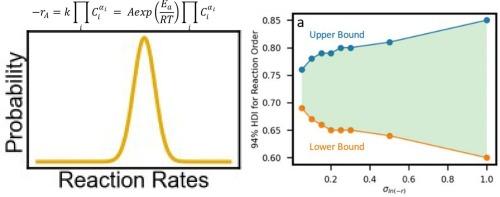A Markov chain Monte Carlo (MCMC) Bayesian inference approach to analyze apparent activation barriers and reaction orders from microreactor data
IF 6.5
1区 化学
Q2 CHEMISTRY, PHYSICAL
引用次数: 0
Abstract
Statistical analysis of steady-state catalytic kinetic data is often limited by data sparsity due to the slow pace at which the data is collected. Data sparsity and limitations in statistical analysis make it difficult to differentiate between mechanistic models and catalytic sites. A Bayesian inference tool is reported for catalysis researchers to estimate error in the determination of reaction orders from steady state microreactor data. The benefits of a Bayesian inference approach are discussed, as an alternative to the more common frequentist approach. The approach incorporates prior knowledge of the system and the data collected to form an error estimate on reaction orders. We investigated the effects of three distinct data treatments—individual fitting of trials, pooled analysis, and constrained regression methods—on the precision and uncertainty of reaction order determinations. To assess the robustness of our findings, we conducted sensitivity analyses to evaluate the influence of Bayesian parameters on uncertainty estimation. Additionally, we utilized synthetic data to illustrate how data quality impacts the precision of uncertainty assessments. We show Bayesian analysis can obtain a more precise estimation of error with a sparse data set than a frequentist analysis. This work provides strong evidence that the adoption of Bayesian analysis of kinetic data may help researchers make more precise arguments as to the strength of their evidence for a particular mechanistic hypothesis, or in comparing across different catalysts.


基于Markov链蒙特卡罗(MCMC)贝叶斯推理方法分析微反应器数据的表观活化障碍和反应顺序
稳态催化动力学数据的统计分析常常受到数据稀疏性的限制,这是由于收集数据的速度很慢。数据的稀疏性和统计分析的局限性使得很难区分机制模型和催化位点。报道了一种贝叶斯推理工具,用于催化研究人员估计从稳态微反应器数据中确定反应顺序的误差。讨论了贝叶斯推理方法的优点,作为更常见的频率方法的替代方法。该方法结合了系统的先验知识和收集的数据,以形成对反应顺序的误差估计。我们研究了三种不同的数据处理方法——试验的个体拟合、合并分析和约束回归方法——对反应顺序确定的精度和不确定性的影响。为了评估我们研究结果的稳健性,我们进行了敏感性分析,以评估贝叶斯参数对不确定性估计的影响。此外,我们利用合成数据来说明数据质量如何影响不确定性评估的精度。我们证明贝叶斯分析可以在稀疏数据集上比频率分析获得更精确的误差估计。这项工作提供了强有力的证据,表明采用贝叶斯分析动力学数据可以帮助研究人员对特定机制假设的证据强度做出更精确的论证,或者在不同催化剂之间进行比较。
本文章由计算机程序翻译,如有差异,请以英文原文为准。
求助全文
约1分钟内获得全文
求助全文
来源期刊

Journal of Catalysis
工程技术-工程:化工
CiteScore
12.30
自引率
5.50%
发文量
447
审稿时长
31 days
期刊介绍:
The Journal of Catalysis publishes scholarly articles on both heterogeneous and homogeneous catalysis, covering a wide range of chemical transformations. These include various types of catalysis, such as those mediated by photons, plasmons, and electrons. The focus of the studies is to understand the relationship between catalytic function and the underlying chemical properties of surfaces and metal complexes.
The articles in the journal offer innovative concepts and explore the synthesis and kinetics of inorganic solids and homogeneous complexes. Furthermore, they discuss spectroscopic techniques for characterizing catalysts, investigate the interaction of probes and reacting species with catalysts, and employ theoretical methods.
The research presented in the journal should have direct relevance to the field of catalytic processes, addressing either fundamental aspects or applications of catalysis.
 求助内容:
求助内容: 应助结果提醒方式:
应助结果提醒方式:


